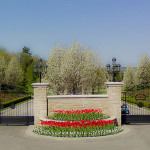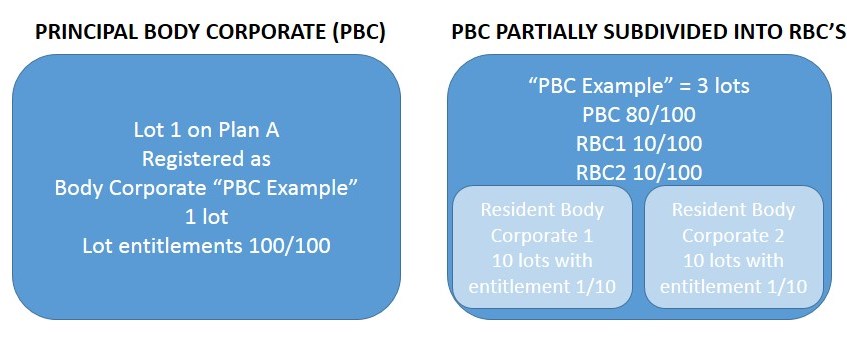 A body corporate layered scheme is, well, exactly what it says; there are layers of body corporates, one contained within the other. They’re precincts of several different body corporates all with joint infrastructure.
A body corporate layered scheme is, well, exactly what it says; there are layers of body corporates, one contained within the other. They’re precincts of several different body corporates all with joint infrastructure.
The over riding principal of all body corporate legislations is fairness; fairness with cost allocations and fairness with use of common property. Layered schemes are created to manage this process when there are multiple relationships that will need to be considered.
The idea is all the lot owners pay for things that affect all the lot owners, and yet each individual body corporate is still autonomous within itself.
Sounds complicated? Yeah, that’s because it really is.
Layered schemes are reasonably common though, so if this affects you, it’s worth getting a handle on it.
How A Body Corporate Layered Scheme Is Created
To create a body corporate layered scheme the developer will find and if necessary, consolidate large blocks of land into one cohesive whole, and register that block as a a body corporate. It becomes the Principal Body Corporate (PBC) and will contain all the land to be developed into lots and common property.
At that point lot entitlements are set.
The development then proceeds in stages with precincts being marked out within the wider PBC to be developed and sub-divided.
Those developments are then registered as separate resident body corporates and the lots contained within those body corporates are then included in the PBC. The diagram below gives you an idea of what it will look like.
Layered Schemes vs Building Management Statements
With layered schemes the body corporates are all contained within one overriding body corporate, or several nested ones even, with the key point being they are contained within one precinct.
A group of lots and body corporates covered by a Building Management Statement (BMS) appears similar but it’s not.
Where a layered scheme is one lot completely contained within another lot, those body corporates covered by a BMS are actually body corporate, or lots, created from excess space within the original lot. That lot has either sold subspace or airspace which has been made into another lot.
What was one lot has now been split into two, which sounds similar to a layered scheme I know, but the distinction is whether or not the new lot has been excised from the existing lot.
With a layered scheme the new lot resides within the PBC and cannot be separated, just like all lots within their body corporates.
With a volumetric lot the new lot exists on it’s own. It exists above or below the original lot, but they are distinctly different lots sharing one space, and the necessary relationship between the two (or more) lots is managed by the BMS.
How Do I Know If My Lot Is Part Of A Layered Scheme
If a lot is contained within a body corporate the CTS number will be included on the title search.
In the case of a lot contained within a Resident Body Corporate, which is itself contained within a Principal Body Corporate, a layered scheme, two CTS numbers will show up on the title search, the CTS of the resident body corporate and the PBC.
A strata search will also tell you if the scheme is part of a layered scheme.
What It All Means To Lot Owners
If a lot in a body corporate is part of a layered scheme there are a number of implications for lot owners including;
- A lot in a resident body corporate will pay levies to the residential body corporate only
- Part of the levies paid by lot owners in resident body corporate will be paid in levies to the PBC
- The resident body corporate will have by-laws that must be observed
- The PBC will also have by-laws that must to be observed by all lot owners in resident body corporates
- The resident body corporate is a lot in the PBC and as such a representative will be eligible to vote at PBC meetings and join the PBC committee
For the most part levies will be higher in a body corporate layered scheme, mostly because they tend to be more complex.
The rules to be followed will also be more stringent, and correspondingly the scheme is likely to be neater, more uniform and better maintained as a result.
The Most Important Point – Cost Sharing
As I noted above the idea with layered schemes is each resident body corporate, or more specifically their lot owners, pays for their own needs.
Joint needs, like roadways in and out of the scheme, shared car parks, shared pools or other facilities, are available to be used by all lot owners across all the RBC’s, including the PBC, so all the lot owners share the costs.
And that right there is the key point and the most common dispute with layered schemes: what qualifies as PBC issues, hence all lot owners must contribute to the cost, and what is RBC issue, hence only those within that RBC must pay.
It’s such an important point, and a critical point for buyers trying to determine viability of a body corporate, that I discuss it in another article here.

 Unless stated otherwise all the information on this website relates to Queensland legislation.
Unless stated otherwise all the information on this website relates to Queensland legislation.
Can a PBC make decisions about Common Property without the consent of the Owners?
Our issue is we have 2 seperate body corporates that have common property and then a committee of just 2 people in a PBC that are making a lot of decisions that can negatively impact owners financially.
We don’t have any governing body for the NT, only the courts.
Hi Lia
The PBC is made up of owners just the same as any other body corporates. The problem is that those owners comprise the two resident body corporates so it’s logical to think that the committee for that scheme is made up of two representatives. They still need to follow all the rules in making decisions, ie some by committee and some by general meeting. Again however, it’s the two representatives that will be voting.
If you’re concerned you could propose a motion within your own scheme that the residential scheme must vote on how the representative is to vote in any PBC meetings. Essentially that would make the votes from your resident scheme the will of the majority of that scheme. You have no control over what happens in the other resident scheme or in fact the PBC.
Our body corporate is part of a layered scheme. However there is no common property joining our scheme to the PBC land. Is this possible.
Hi Lyndon
Absolutely. There are some layered schemes where all the common property is in the PBC.
Usually it comes up where a deal has been done with the local council that they take over the roads. Unfortunately for the schemes it now means they have less control over what people park on the roads since now they are council land and subject to local by-laws rather than the scheme by-laws.
Can we implement a layered scheme on a building with a Body Corporate already? We have Retail, a Hotel and residential it is hard to get things done if the Hotel is not in agreement.
Hi Clare
I think you probably could, but I’m not a professional in that area. You’d need to take to a town planner for sure. I don’t know that it would even be the best way to make the changes you want. Depends on what the specific changes are. Maybe a building management statement / group would be a better fit.
Any change like that at body corporate level would require a resolution without dissent, which makes it unlikely to proceed.
We are part of 2 body corps under a PBC arrangement and which the pbc has control of the marina berth (16 berths) as the pbc has its own cts plan and currently only has 2 representatives are we as lot owners of berths able to a body corporate committee of 3,5 or 7 people to represent us
Hi John
The marina berths are not a separate body corporate; they are not even a lot as such. They are a facility of the PBC. Their management is governed by the committee for the PBC.
So, no, there is no facility for that to happen.